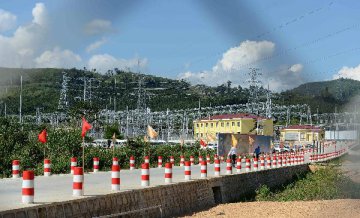VIENTIANE, Feb. 17 (Xinhua) -- The under-construct China-Laos railway has brought luck to local compensated land owners, Lao state-run daily Vientiane Times reported on Monday.
Bounying Luanglath, a 60-year-old man living in Vientiane capital, is delighted to have a new home and a plot of land after being awarded compensation for the loss of his former home by the developers of the China-Laos railway.
Bounying is one of 85 land owners in Donnoun village, Xaythany district of Lao capital Vientiane, who have received payments from the developer after their land was expropriated to allow for construction of the railway, which terminates on the outskirts of Vientiane capital.
The 414-km railway, with 198-km tunnels and 62-km bridges, will run from Boten border gate in northern Laos, bordering China, to Vientiane.
Bounying and his neighbors gave up their homes to make way for the railway. He is now able to open the front door of the single-storey house that was built in August 2019 to welcome friends.
In January 2019, the authorities agreed to pay Bounying a sum of over 800 million Lao kip (some 89,837 U.S. dollars). Of the more than 60 land owners compensated, he was the first to receive a payout during the first phase of compensation awards.
The Deputy Governor of Xaythany district, Bounvanh Chaksuakao, said the payment of compensation for a 9.7-km-long stretch of land in his district is almost complete.
Laying of the railway track in Xaythany district is expected to be complete in April. "It will be a historic moment for our district when the railway is completed," said Bounvanh. He is optimistic that the railway will create jobs for local people as a station is located in the district.
Average per capita income in the district was 3,000 U.S. dollars in 2019. The value of foreign investment in Xaythany district now exceeds 500 billion Lao kip (some 56 million U.S. dollars), most of it in sectors such as livestock, markets, shopping centers and hotels.
The China-Laos Railway is a strategic docking project between the China-proposed Belt and Road Initiative and Laos' strategy to convert itself from a landlocked country to a land-linked hub.
The electrified passenger and cargo railway is built with the full application of Chinese management and technical standards.
The project started in December 2016 and is scheduled to be completed and opened to traffic in December 2021.
Bounying Luanglath, a 60-year-old man living in Vientiane capital, is delighted to have a new home and a plot of land after being awarded compensation for the loss of his former home by the developers of the China-Laos railway.
Bounying is one of 85 land owners in Donnoun village, Xaythany district of Lao capital Vientiane, who have received payments from the developer after their land was expropriated to allow for construction of the railway, which terminates on the outskirts of Vientiane capital.
The 414-km railway, with 198-km tunnels and 62-km bridges, will run from Boten border gate in northern Laos, bordering China, to Vientiane.
Bounying and his neighbors gave up their homes to make way for the railway. He is now able to open the front door of the single-storey house that was built in August 2019 to welcome friends.
In January 2019, the authorities agreed to pay Bounying a sum of over 800 million Lao kip (some 89,837 U.S. dollars). Of the more than 60 land owners compensated, he was the first to receive a payout during the first phase of compensation awards.
The Deputy Governor of Xaythany district, Bounvanh Chaksuakao, said the payment of compensation for a 9.7-km-long stretch of land in his district is almost complete.
Laying of the railway track in Xaythany district is expected to be complete in April. "It will be a historic moment for our district when the railway is completed," said Bounvanh. He is optimistic that the railway will create jobs for local people as a station is located in the district.
Average per capita income in the district was 3,000 U.S. dollars in 2019. The value of foreign investment in Xaythany district now exceeds 500 billion Lao kip (some 56 million U.S. dollars), most of it in sectors such as livestock, markets, shopping centers and hotels.
The China-Laos Railway is a strategic docking project between the China-proposed Belt and Road Initiative and Laos' strategy to convert itself from a landlocked country to a land-linked hub.
The electrified passenger and cargo railway is built with the full application of Chinese management and technical standards.
The project started in December 2016 and is scheduled to be completed and opened to traffic in December 2021.
















Latest comments